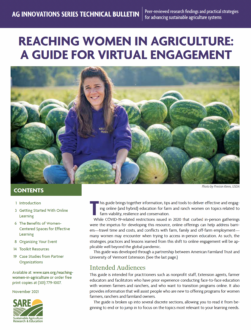It Takes a Network
We are grateful to the many farmer organizations and Extension professionals who shared information, tips and lessons learned over the past several months. This guide would not have been possible without their generous contributions.
Funding for this guide was made possible by the Natural Resource Conservation Service, University of Vermont, and the National Institute of Food and Agriculture, USDA under award number 2014-68006-21873.
Authors: Ashley Brucker (AFT), Beth Holtzman, (University of Vermont), Caitlin Joseph (AFT) and Gabrielle Roesch-McNally (AFT)
Case study contributors: Cayla Bendel (Pheasants Forever), Jean Eells (E Resources Group and Women Food and Agriculture Network), Lisa Kivirist (In Her Boots, Midwest Organic Sustainable Education Service), Elizabeth Lillard (Women in Conservation Leadership, National Wildlife Federation), and Maggie Norton (Practical Farmers of Iowa)
Recommended Citation
Brucker, A., Holtzman, B., Joseph, C., Roesch-McNally, G. (2020). Reaching Women in Agriculture: A Guide for Virtual Engagement. Washington D.C.: American Farmland Trust and the University of Vermont. https://farmland.org/virtual-learning-circle-guide/.
References
Ingalhalikar, et al. (2014). Sex differences in the structural connectome of the human brain. Proceedings of the National Academy of Sciences 111(2): 823–828.
Kanjere, A. (2019). Defending race privilege on the Internet: how whiteness uses innocence discourse online. Published online: Information, Communication & Society 22(14): 2156–2170.
Nakamura, L. and P. Chow-White. (2012). Introduction – race and digital technology: Code, the color-line, and the information society. In Race after the Internet (pp. 1–18). Routledge: New York, NY.
Tolbert, C. J. and K. Mossberger. (2006). New inequality frontier: Broadband Internet access. Economic Policy Institute Working Paper 275.
Federal Communications Commission. (2020). Bridging the Digital Divide for All Americans.
Horst, M. and A. Marion. (2019). Racial, ethnic and gender inequities in farmland ownership and farming in the US. Agriculture and Human Values 36(1): 1–16.
Bell, S. and J. McAllister. (2021). Sustainable Agriculture Through Sustainable Learning: An Educator’s Guide to Best Practices for Adult Learning. Sustainable Agriculture Research and Education (SARE): College Park, MD.
Hammond, Z. (2014). Culturally Responsive Teaching and the Brain: Promoting Authentic Engagement and Rigor Among Culturally and Linguistically Diverse Students. Corwin Press: Thousand Oaks, CA.
Boilerplate for the footer on the last page:
This guide was developed in a partnership between American Farmland Trust and University of Vermont Extension, with funding provided by the USDA Natural Resources Conservation Service, University of Vermont, and the USDA National Institute of Food and Agriculture (NIFA), under award number 2014-68006-21873. It was published by the Sustainable Agriculture Research and Education (SARE) program with funding from USDA-NIFA under award number 2019-38640-29881. Any opinions, findings, conclusions or recommendations expressed here do not necessarily reflect the view of the USDA.
